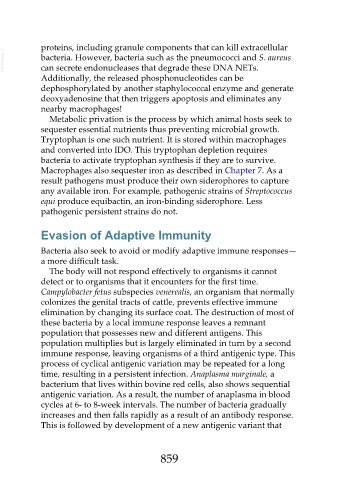Page 859 - Veterinary Immunology, 10th Edition
P. 859
proteins, including granule components that can kill extracellular
VetBooks.ir bacteria. However, bacteria such as the pneumococci and S. aureus
can secrete endonucleases that degrade these DNA NETs.
Additionally, the released phosphonucleotides can be
dephosphorylated by another staphylococcal enzyme and generate
deoxyadenosine that then triggers apoptosis and eliminates any
nearby macrophages!
Metabolic privation is the process by which animal hosts seek to
sequester essential nutrients thus preventing microbial growth.
Tryptophan is one such nutrient. It is stored within macrophages
and converted into IDO. This tryptophan depletion requires
bacteria to activate tryptophan synthesis if they are to survive.
Macrophages also sequester iron as described in Chapter 7. As a
result pathogens must produce their own siderophores to capture
any available iron. For example, pathogenic strains of Streptococcus
equi produce equibactin, an iron-binding siderophore. Less
pathogenic persistent strains do not.
Evasion of Adaptive Immunity
Bacteria also seek to avoid or modify adaptive immune responses—
a more difficult task.
The body will not respond effectively to organisms it cannot
detect or to organisms that it encounters for the first time.
Campylobacter fetus subspecies venerealis, an organism that normally
colonizes the genital tracts of cattle, prevents effective immune
elimination by changing its surface coat. The destruction of most of
these bacteria by a local immune response leaves a remnant
population that possesses new and different antigens. This
population multiplies but is largely eliminated in turn by a second
immune response, leaving organisms of a third antigenic type. This
process of cyclical antigenic variation may be repeated for a long
time, resulting in a persistent infection. Anaplasma marginale, a
bacterium that lives within bovine red cells, also shows sequential
antigenic variation. As a result, the number of anaplasma in blood
cycles at 6- to 8-week intervals. The number of bacteria gradually
increases and then falls rapidly as a result of an antibody response.
This is followed by development of a new antigenic variant that
859

